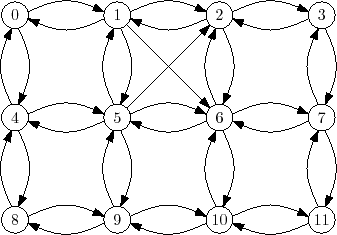Next: 12.3 Graph Traversal Up: 12. Graphs Previous: 12.1 AdjacencyMatrix: Representing a Contents
Adjacency list representations takes a more vertex-centric
approach. There are many different possible implementations of
adjacency lists. In this section, we present a simple one. At the end
of the section, we discuss different possibilities. In an adjacency
list representation, the graph ![]() is represented as an array,
is represented as an array,
![]() , of lists. The list
, of lists. The list
![]() contains a list of all the vertices
adjacent to vertex
contains a list of all the vertices
adjacent to vertex
![]() . That is, it contains every index
. That is, it contains every index
![]() such that
such that
![]() .
.
int n;
List<Integer>[] adj;
AdjacencyLists(int n0) {
n = n0;
adj = (List<Integer>[])new List[n];
for (int i = 0; i < n; i++)
adj[i] = new ArrayStack<Integer>(Integer.class);
}
(An example is shown in Figure 12.3.) In this particular
implementation, we represent each list in

|
The
![]() operation just appends the value
operation just appends the value
![]() to the list
to the list
![]() :
:
void addEdge(int i, int j) {
adj[i].add(j);
}
This takes constant time.
The
![]() operation searches through the list
operation searches through the list
![]() until it finds
until it finds
![]() and then removes it:
and then removes it:
void removeEdge(int i, int j) {
Iterator<Integer> it = adj[i].iterator();
while (it.hasNext()) {
if (it.next() == j) {
it.remove();
return;
}
}
}
This takes
The
![]() operation is similar; it searches through the list
operation is similar; it searches through the list
![]() until it finds
until it finds
![]() (and returns true), or reaches the end of
the list (and returns false):
(and returns true), or reaches the end of
the list (and returns false):
boolean hasEdge(int i, int j) {
return adj[i].contains(j);
}
This also takes
The
![]() operation is very simple; It simply returns
the list
operation is very simple; It simply returns
the list
![]() :
:
List<Integer> outEdges(int i) {
return adj[i];
}
This clearly takes constant time.
The
![]() operation is much more work. It scans over every
vertex
operation is much more work. It scans over every
vertex ![]() checking if the edge
checking if the edge
![]() exists and, if so, adding
exists and, if so, adding
![]() to the output list:
to the output list:
List<Integer> inEdges(int i) {
List<Integer> edges = new ArrayStack<Integer>(Integer.class);
for (int j = 0; j < n; j++)
if (adj[j].contains(i)) edges.add(j);
return edges;
}
This operation is very slow. It scans the adjacency list of every vertex,
so it takes
The following theorem summarizes the performance of the above data structure:
As alluded to earlier, there are many different choices to be made when implementing a graph as an adjacency list. Some questions that come up include:
opendatastructures.org